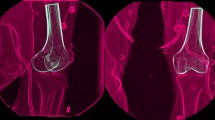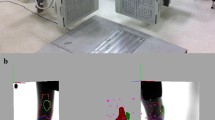Abstract
Individual variations in joint anatomy, tissue mechanical properties, and muscle strength of the knee are believed to affect the clinical outcome of ACL-deficient patients, but the effects have not been studied systematically. The impact of individual anthropometric and mechanical variation on functional stability of the ACL-deficient knee was investigated in this study using a two-dimensional mathematical knee model. The model included the tibiofemoral and the patellofemoral articulations, four ligaments, the medial capsule, and four muscle units surrounding the knee. Simulations were conducted to determine tibial anterior translation as well as tibiofemoral and patellofemoral joint loading at a single selected position during early stance phase of gait. Incremental hamstring muscle forces were applied to the modeled ACL-deficient knee in order to examine the level of the hamstring muscle forces required to prevent abnormal tibial anterior translation relative to the femur. Simulations were repeated using incremental variations in the selected anthropometric and mechanical properties of the ACL-deficient knee. It was found that bony geometry of the knee joint, especially the slope of tibial plateau, strongly affected both the tibial translations in the ACL-deficient knee and the effectiveness of the hamstring muscles to compensate for the ACL deficiency. For instance, simulations indicated that, due to ACL deficiency, the tibial anterior displacement increased by 9.1 mm for a tibial slope angle of 4° compared to 15.2 mm for a tibial slope angle of 12°. Future outcome studies for ACL-deficient knee may be required to include individual anthropometric and mechanical parameters of the knee as covariants. © 2003 Biomedical Engineering Society.
PAC2003: 8719Rr, 8719Ff, 8719St
Similar content being viewed by others
References
Abdel-Rahman, E., and M. S. Hefzy. A two-dimensional dynamic anatomical model of the human knee joint. J. Biomech. Eng. 115:357–365, 1993.
Allen, C. R., E. K. Wong, G. A. Livesay, M. Sakane, F. H. Fu, and S. L. Woo. Importance of the medial meniscus in the anterior cruciate ligament-deficient knee. J. Orthop. Res. 18:109–115, 2000.
Andriacchi, T. Dynamics of pathological motion: Applied to the anterior cruciate deficient knee. J. Biomech. 23:99–105, 1990.
Berchuck, M., T. P. Andriacchi, B. R. Bach, and B. Reider. Gait adaptations by patients who have a deficient anterior cruciate ligament. 72A, 871–877, 1990.
Beynnon, B., J. Yu, D. Huston, B. Fleming, R. Johnson, L. Haugh, and M. H. Pope. A sagittal plane model of the knee and cruciate ligaments with application of a sensitivity analysis. J. Biomech. Eng. 118:227–239, 1996.
Blankevoort, L., R. Huiskes, and A. de Lange. Recruitment of knee joint ligaments. J. Biomech. Eng. 113:94–103, 1991.
Blankevoort, L., and R. Huiskes. Validation of a three-dimensional model of the knee. J. Biomech. 29:955–961, 1996.
Butler, D. L., F. R. Noyes, and E. S. Grood. Ligamentous restraints to anterior-posterior drawer in the human knee. 62A, 259–270, 1980.
Butler, D. L., E. S. Grood, F. R. Noyes, and A. N. Sodd. On the interpretation of our anterior cruciate ligament data. Clin. Orthop. 196:26–34, 1985.
Daniel, D. M. Selecting patients for ACL surgery. The Anterior Cruciate Ligament: Current and Future Concepts. New York: Raven, 1993, pp. 251–258.
Dejour, H., P. Neyret, and M. Bonnin. Monopodal weight-bearing radiography of the chronically unstable knee, edited by R. Jakob and H.-U. Staubli. Knee and the Cruciate Ligaments: Anatomy, Biomechanics, Clinical Aspects, Reconstruction, Complications, Rehabilitation. Berlin: Springer, 1992, pp. 568–576.
Delp, S. L. Ph.D. dissertation, Stanford University, Stanford, CA, 1990.
Elias, S. G., M. A. R. Freeman, and E. I. Gokcay. A correlative study of the geometry and anatomy of the distal femur. Clin. Orthop. 260:98–103, 1990.
Friederich, J. A., and R. A. Brand. Muscle fiber architecture in the human lower limb. J. Biomech. 23:91–95, 1990.
Fukubayashi, T., P. A. Torzilli, M. F. Sherman, and R. F. Warren. An biomechanical evaluation of anterior–posterior motion of the knee. 64A, 258–264, 1982.
Garg, A., and P. S. Walker. Prediction of total knee motion using a three-dimensional computer-graphics model. J. Biomech. 23:45–58, 1990.
Giove, T. P., S. J. Miller, B. E. Kent, T. L. Stanford, and J. G. Garrick. Nonoperative treatment of the torn anterior cruciate ligament. 65A, 184–192, 1983.
Haimes, J. L., R. R. Wroble, E. S. Grood, and F. R. Noyes. Role of the medial structures in the intact and ACL-deficient knee. Am. J. Sports Med. 22:402–409, 1994.
Harrington, I. J. A bioengineering analysis of force actions at the knee in normal and pathological gait. J. Biomech. Eng. 11:167–172, 1976.
Hefzy, M. A., and E. S. Grood. Sensitivity of insertion locations on length patterns of anterior cruciate ligament fibers. J. Biomech. Eng. 108:73–82, 1986.
Hefzy, M. A., E. S. Grood, and F. R. Noyes. Factors affecting the region of most isometric femoral attachments, Part II: the anterior cruciate ligament. Am. J. Sports Med. 17:208–216, 1989.
Jackson, R. W., R. I. Peters, and R. L. Marczyk. Late results of untreated anterior cruciate ligament rupture (abstract). 62b, 127, 1980.
Jacobsen, K. Osteoarthrosis following insufficiency of the cruciate ligaments in man. Acta Orthop. Scand. 48:520–526, 1977.
Jakob, R. P. Knee and the Cruciate Ligaments: Anatomy, Biomechanics, Clinical Aspects, Reconstruction, Complications, Rehabilitation. Berlin: Springer, 1992, pp. 270–275.
Kadaba, M. P., H. K. Ramakrishnan, M. E. Wootten, J. Gainey, G. Gorton, and G. V. Cochran. Repeatability of kinematic, kinetic, and electromyographic data in normal adult gait. J. Orthop. Res. 7:849–860, 1989.
Kålund, S., T. Sinkjær, L. Arendt-Nielsen, and O. Simonsen. Altered timing of hamstring muscle action in anterior cruciate ligament deficient patients. Am. J. Sports Med. 18:245–248, 1990.
Kannua P., and M. Jarvinen. Conservatively treated tears of the anterior cruciate ligament. 69A, 1007–1012, 1987.
Lafortune, M. A., P. R. Cavanagh, H. J. Sommer, and A. Kalenak. Three-dimensional kinematics of the human knee during walking. J. Biomech. 25:347–357, 1992.
Li, G., T. W. Rudy, C. Allen, M. Sakane, and S. L. Y. Woo. Effect of combined axial compressive and anterior tibial loads on forces in the anterior cruciate ligament: A porcine study. J. Orthop. Res. 16:122–127, 1998.
Liu, W., and M. Maitland. The effect of hamstring compensation for anterior laxity in the ACL-deficient knee during gait. J. Biomech. 33:871–879, 2000.
Maitland, M. E., G. D. Bell, N. G. H. Mohtadi, and W. Herzog. Quantitative analysis of anterior cruciate ligament instability. Clin. Biomech. (Los Angel.)10:93–97, 1995.
McDaniel, W. J., and T. B. Dameron. The untreated anterior cruciate ligament rupture. Clin. Orthop. 172:158–163, 1983.
Nisell, R., G. Nemeth, and H. Ohlsen. Joint forces in extension of the knee. Acta Orthop. Scand. 57:41–46, 1986.
Noyes, F. R., P. A. Mooar, D. S. Mathews, and D. L. Butler. The symptomatic anterior cruciate-deficient knee. Part I. The long-term functional disability in athletically active individuals. 65A, 154–162, 1983a.
Noyes, F. R., D. S. Mathews, P. A. Mooar, and E. S. Grood. The symptomatic anterior cruciate-deficient knee. Part II. The results of rehabilitation, activity modification and counseling on functional disability. 65A, 163–174, 1983b.
Odensten, M., and J. Gillquist. Functional anatomy of the anterior cruciate ligament and a rationale for reconstruction. 67A, 257–262, 1985.
Shelburne, K. B., and M. G. Pandy. A musculoskeletal model of the knee for evaluating ligament forces during isometric contractions. J. Biomech. 30:163–176, 1997.
Snyder-Mackler, L., G. K. Fitzgerald, A. R. Bartolozzi, and M. G. Ciccotti. The relationship between passive joint laxity and functional outcome after anterior cruciate ligament injury. Am. J. Sports Med. 25:191–195, 1997.
Solomonow, M., R. Baratta, B. H. Zhou, H. Shoji, W. Bose, C. Beck, and R. D'Ambrosia. The synergistic action of the anterior cruciate ligament and thigh muscles in maintaining joint stability. Am. J. Sports Med. 15:207–213, 1987.
Sullivan D., M. Levy, S. Sheskier, P. A. Torzilli, and R. F. Warren. Medial restraints to anterior-posterior motion of the knee. 66A, 930–936, 1984.
Torzilli P. A., R. L. Greenberg, R. W. Hood, H. Pavlov, and J. N. Insall. Measurement of anterior-posterior motion of the knee in injured patients using a biomechanical stress technique. 66A, 1438–1442, 1984.
Torzilli, P. A., X. Deng, and R. F. Warren. The effect of joint-compressive load and quadriceps muscle force on knee motion in the intact and anterior cruciate ligament-sectioned knee. Am. J. Sports Med. 22:105–112, 1994.
Tumer, S. T., and A. E. Engin. Three-body segment dynamic model of the human knee. J. Biomech. Eng. 115:350–356, 1993.
Walla, D. J., J. Albright, E. McAuley, R. K. Martin, V. Eldridge, and G. El-Khoury. Hamstring control and the unstable anterior cruciate ligament-deficient knee. Am. J. Sports Med. 13:34–39, 1985.
Warren, R. F., and I. M. Levy. Meniscal lesions associated with anterior cruciate ligament injury. Clin. Orthop. 172:32–37, 1983.
Winter, D. A. Biomechanics and Motor Control of Human Movement, 2nd ed. New York: Wiley, 1990.
Wismans, J., F. Veldpaus, and J. Janssen. A three-dimensional mathematical model of the knee-joint. J. Biomech. 13:677–685, 1980.
Yamaguchi, G. T., and F. E. Zajac. A planar model of the knee joint to characterize the knee extensor mechanism. J. Biomech. 22:1–10, 1989.
Author information
Authors and Affiliations
Rights and permissions
About this article
Cite this article
Liu, W., Maitland, M.E. Influence of Anthropometric and Mechanical Variations on Functional Instability in the ACL-Deficient Knee. Annals of Biomedical Engineering 31, 1153–1161 (2003). https://doi.org/10.1114/1.1615572
Issue Date:
DOI: https://doi.org/10.1114/1.1615572




